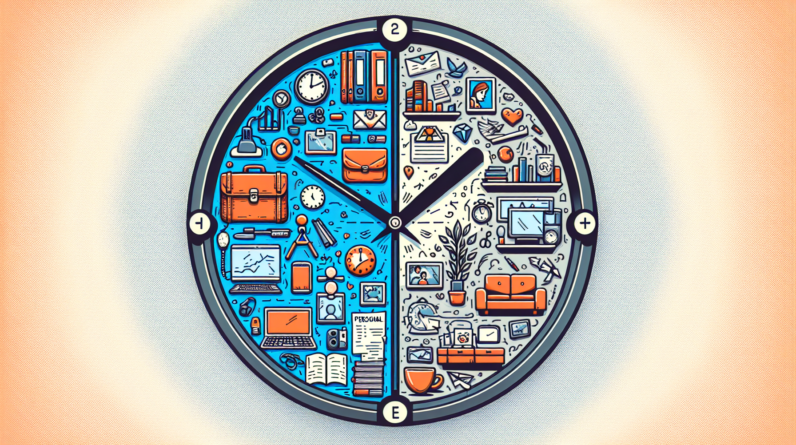
Are you tired of feeling overwhelmed by the constant juggling act between your professional and personal life? Look no further! In this article, we will explore practical strategies that will help you navigate the delicate balance between work and life. From setting boundaries to prioritizing self-care, you’ll discover effective ways to achieve work-life integration without sacrificing your well-being or career success. Get ready to reclaim control over your life and create a harmonious blend that brings fulfillment in both your professional and personal endeavors.
Understanding Work-Life Integration
work-life integration is a concept that emphasizes the blending of personal and professional life in a way that allows individuals to achieve a harmonious balance between the two. Unlike work-life balance, which suggests a strict separation of work and personal life, work-life integration promotes the idea that both aspects can coexist and complement each other.
Defining work-life integration
Work-life integration is about finding ways to incorporate your personal life into your work-life and vice versa, allowing for flexibility in your daily routines and activities. It involves combining work tasks with personal responsibilities and interests, creating a seamless transition between the two. This approach recognizes that work and personal life are interconnected, and it is possible to achieve success in both areas without sacrificing one for the other.
Benefits of work-life integration
Embracing work-life integration offers numerous benefits. Firstly, it allows for increased flexibility, enabling individuals to attend to personal commitments such as family events or appointments while still fulfilling their professional responsibilities. This flexibility reduces stress and promotes overall well-being.
Secondly, work-life integration enhances productivity. By integrating personal interests and hobbies into work, individuals can harness their passions and motivations to excel in their professional endeavors. This integration drives creativity and innovation, leading to increased job satisfaction and performance.
Lastly, work-life integration promotes a sense of fulfillment. When individuals can engage in activities they enjoy both inside and outside of work, they experience a greater sense of purpose and satisfaction in their lives. This holistic approach to life contributes to overall happiness and better mental health.
Identifying Your Priorities
To achieve successful work-life integration, it is essential to identify and prioritize what truly matters to you on both personal and professional fronts.
Determining personal and professional priorities
Take time to reflect on your values, goals, and aspirations. What are the most important things in your personal life? Is it spending quality time with family and friends, pursuing hobbies, or taking care of your health and well-being? On the professional front, consider your career ambitions and what you hope to achieve in your job. Identifying these priorities will help you make informed decisions regarding how to integrate work and personal life effectively.
Aligning priorities with long-term goals
Once you have identified your priorities, align them with your long-term goals. Consider where you want to be in the future both personally and professionally. Does your current approach to work-life allow you to progress towards these goals? If not, it may be necessary to make adjustments and realign your priorities to ensure a more cohesive integration of work and personal life.
Setting Boundaries
Establishing boundaries between work and personal life is crucial for maintaining a healthy work-life integration. Here are some strategies to help you set and maintain boundaries effectively.
Creating a schedule and sticking to it
Set clear working hours and create a schedule that accommodates your personal commitments. Communicate this schedule to colleagues and family members, so they are aware of when you are available for work-related tasks and when you need time for yourself or family activities. Sticking to your schedule helps maintain a sense of predictability and balance in your life.
Learning to say no
It can be challenging to say no, especially when work demands are high or personal obligations arise. However, learning to set boundaries by politely declining tasks or requests that exceed your capacity is essential for maintaining work-life integration. Remember, saying no allows you to prioritize your well-being and ensures that you can give your best to the tasks and activities you commit to.
Managing digital boundaries
In today’s digital age, it is crucial to establish boundaries around technology usage. Set specific times during the day to disconnect from work emails and notifications, allowing yourself to focus on personal activities without interruptions. Additionally, avoid checking work-related messages outside of designated working hours, unless it is truly urgent. By managing digital boundaries, you can prevent work from infiltrating your personal life and vice versa.
Building a Supportive Network
Having a strong support system is essential for navigating work-life integration successfully. Here are two areas where you can seek support:
Seeking support from family and friends
Your family and friends play a vital role in supporting your work-life integration. They can provide valuable guidance, understanding, and help when you need to juggle responsibilities. Communicate your goals and challenges with them, and work together to find solutions that suit everyone involved. Lean on your loved ones during demanding times, and reciprocate their support when they need it.
Creating a support system at work
Building a supportive network at work is equally important. Seek connections with colleagues who share similar values and goals, creating an environment that encourages work-life integration. Collaboration and teamwork can facilitate the sharing of responsibilities and provide a sense of camaraderie. Engage in open and honest communication with your supervisor and colleagues, discussing strategies to maintain work-life integration while achieving team goals.
Finding a mentor or coach
Having a mentor or coach can be highly beneficial in guiding you through the process of work-life integration. They can offer insights, advice, and strategies based on their own experiences, helping you navigate challenges and set realistic expectations. A mentor or coach can provide valuable perspective and support, empowering you to make decisions that align with your long-term goals and priorities.
Prioritizing Self-Care
Taking care of yourself is crucial for maintaining a healthy work-life integration. Prioritizing self-care ensures that you have the physical, emotional, and mental energy to thrive in both personal and professional aspects of your life.
Recognizing the importance of self-care
Self-care encompasses activities that promote physical health, emotional well-being, and mental rejuvenation. It involves engaging in activities that bring you joy, relaxation, and fulfillment. Recognize that prioritizing self-care is not selfish, but rather an essential component of achieving work-life integration. By taking care of yourself, you are better equipped to handle the demands of work and personal life.
Incorporating self-care activities into your routine
Identify self-care activities that resonate with you and incorporate them into your daily or weekly routine. This can include exercise, meditation, spending time in nature, pursuing hobbies, or engaging in activities that recharge your energy. Make self-care a non-negotiable part of your schedule, just like any other commitment. Remember, self-care is an investment in your overall well-being and enhances your ability to perform at your best.
Practicing stress management techniques
Stress is inevitable in both personal and professional life. To effectively manage stress, develop strategies that work for you. This can include practicing deep breathing exercises, taking short breaks during the workday, journaling, or engaging in mindfulness practices. Experiment with different techniques to find what helps you relax and manage stress effectively. By incorporating stress management techniques into your routine, you can navigate challenges with resilience and maintain a balanced work-life integration.
Maximizing Productivity
Maximizing productivity is crucial for achieving success in both personal and professional endeavors. Here are some strategies to boost productivity:
Effective time management strategies
Implement time management techniques such as prioritizing tasks, utilizing to-do lists, and setting deadlines. Break down larger tasks into smaller, more manageable steps, allowing for focused and efficient work. Adopting effective time management strategies helps you accomplish tasks effectively while leaving time for personal pursuits.
Setting realistic goals and expectations
Establish realistic goals that align with your priorities and long-term aspirations. Avoid overcommitting or setting unrealistic expectations for yourself. Set achievable targets that challenge you but allow for work-life integration. By setting realistic goals, you can maintain motivation and avoid burnout.
Eliminating distractions
Identify and eliminate or minimize distractions that hinder your productivity. This can include turning off notifications on your phone, designating specific times for checking emails, or creating a designated workspace that is free from distractions. Minimizing interruptions allows for increased focus and efficiency, enhancing your productivity and work-life integration.
Delegating tasks when appropriate
Recognize that you cannot do everything yourself. Delegate tasks to colleagues or family members when appropriate, allowing for a more balanced distribution of responsibilities. Delegating not only lightens your workload but also promotes collaboration and shared accountability, benefiting both personal and professional spheres of your life.
Utilizing Technology
Leveraging technology can significantly enhance work-life integration. Here’s how you can effectively utilize technology:
Leveraging technology for work-life integration
Technology can streamline tasks and increase efficiency, making work-life integration more achievable. Utilize collaboration tools that enable remote work and video conferencing for effective communication. Embrace digital productivity tools that help organize tasks, set reminders, and automate processes. By leveraging technology effectively, you can seamlessly integrate work and personal life, making the most of available resources.
Utilizing productivity tools and apps
There are numerous productivity tools and apps available to facilitate work-life integration. Explore options like project management tools, task managers, and time-tracking apps that align with your needs. Experiment with different tools to find ones that enhance your productivity and streamline your workflows. Remember to use technology mindfully and set boundaries to prevent it from becoming a source of distraction that disrupts work-life integration.
Managing communication effectively
clear and efficient communication is vital for work-life integration. Utilize communication platforms that streamline conversations, reducing the need for lengthy emails or unnecessary meetings. Set expectations around response times and availability, ensuring that communication is respectful of personal boundaries. By managing communication effectively, you can maintain a healthy balance between work and personal life.
Flexibility in the Workplace
The traditional notion of a fixed 9-to-5 work schedule is gradually evolving, with increased emphasis on flexibility in the workplace. Here’s how you can embrace flexibility for better work-life integration:
Negotiating flexible work arrangements
If possible, explore options for flexible work arrangements with your employer. This can include adjusting your working hours, working remotely part-time, or adopting a compressed workweek schedule. Negotiating flexible work arrangements allows you to allocate time for personal responsibilities while maintaining productivity and meeting work obligations.
Capitalizing on remote work opportunities
Remote work offers a unique opportunity for work-life integration. When working remotely, you have greater control over your schedule, allowing for increased flexibility to attend to personal activities. Capitalize on remote work opportunities by setting up a conducive workspace, establishing clear boundaries, and maximizing technology to stay connected and productive.
Adapting to hybrid work models
Some organizations adopt hybrid work models, combining on-site and remote work. Embrace this model by effectively managing your time and creating a routine that balances both work environments. Make the most of face-to-face interactions with colleagues during on-site workdays, and leverage flexibility during remote work days.
Maintaining Work-Life Balance
While work-life integration focuses on blending work and personal life, it is essential to recognize the difference between integration and balance. Work-life balance emphasizes maintaining equilibrium between work and personal life. Here’s how you can maintain work-life balance while integrating the two:
Recognizing the difference between integration and balance
Work-life integration involves intertwining personal and professional aspects seamlessly, while work-life balance emphasizes creating boundaries and allocating specific time for work and personal pursuits. Recognize that achieving complete balance may not always be possible, and work-life integration offers a more flexible and adaptable approach.
Finding harmony between work and personal life
Strive for harmony by continuously assessing and readjusting the allocation of time and energy between work and personal life. Regularly evaluate whether your current approach is enabling you to fulfill your priorities and goals effectively. Adjustments may be necessary from time to time to ensure harmony and avoid one aspect overpowering the other.
Avoiding burnout
Burnout can occur when work and personal obligations become overwhelming, leading to physical and emotional exhaustion. To avoid burnout, prioritize self-care, set boundaries, and recognize when rest is needed. Regularly assess your workload and adjust commitments if necessary. Remember, work-life integration should enhance your overall well-being and not lead to burnout.
Continual Evaluation and Adjustment
Work-life integration is a continual process that requires periodic evaluation and adjustment. Here’s how you can navigate this ongoing journey effectively:
Assessing work-life integration regularly
Regularly assess how well your current approach to work-life integration is functioning. Reflect on whether you are achieving your personal and professional goals, maintaining a healthy balance, and experiencing overall satisfaction. If you notice areas that need improvement or misalignments with your priorities, it may be time to make adjustments.
Making necessary adjustments
Based on your assessments, make any necessary adjustments to your routines, boundaries, or priorities. Be open to adapting and finding new strategies that better support your work-life integration. Remain flexible and willing to experiment with different approaches until you find what works best for you.
Seeking feedback and adapting
Seek feedback from trusted mentors, colleagues, or loved ones who can provide insights and perspective on your work-life integration. Their perspectives can help you identify blind spots or opportunities for improvement. Be open to feedback and adapt your strategies accordingly. Utilize feedback as an opportunity for growth and continued progress in achieving work-life integration.
Navigating work-life integration requires intention, self-reflection, and ongoing adjustments. By understanding the concept, identifying priorities, setting boundaries, building a support system, prioritizing self-care, maximizing productivity, utilizing technology, embracing flexibility, maintaining work-life balance, and continually evaluating and adjusting, you can achieve a more harmonious and fulfilling blend between your personal and professional life. Remember, work-life integration is a dynamic and individualized journey that requires both effort and self-compassion. Embrace the process and enjoy the benefits of a well-integrated life!








